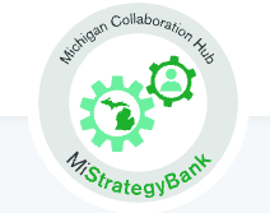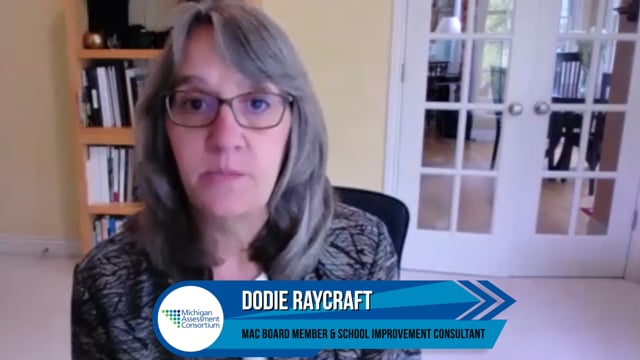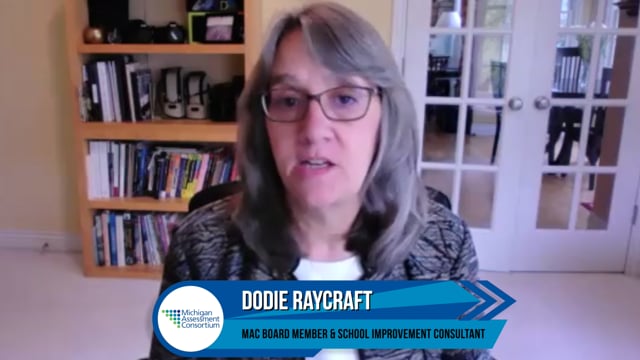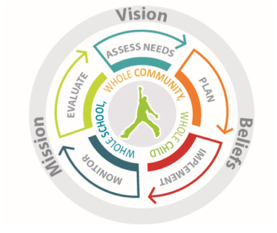How does assessment support a continuous improvement process?
A balanced assessment system helps provide information and data that is needed to implement the continuous improvement process, and ultimately, improve student achievement.
Continuous improvement is a process that helps people in a system—from a school building to a district—set goals, identify strategies for improvement, and evaluate change. Collection and use of data is a key part of the process, and a balanced assessment system helps provide critical data to schools and districts.
Michigan Integrated Continuous Improvement Process (MICIP)
Michigan Strategy Bank

The MiStrategyBank (MSB) is an electronic clearinghouse of strategies designed to connect educational data systems, promote and support best practices, and provide information regarding the implementation of strategies to support Michigan’s education system. Schools and districts can search the MSB to locate information about strategies that pertain to areas they want to improve. Visit Michigan Association of Intermediate School Administrators (MAISA) to request an account to the MSB.
We developed two types of tools to help you use MAC resources as part of the MICIP process: Strategy Guides and Planning Tools. Both types of documents include links to professional learning resources.
Strategy Implementation Guides
A Strategy Guide defines and explains the critical components of a strategy.

Planning Tools
Planning Tools describe activities and steps needed to successfully implement a strategy.

How We Contribute to the MI-Strategy Bank
Jump to:

Implementing a Balanced Assessment System
Schools can move student learning forward by implementing comprehensive and balanced assessment systems that meet the learning, teaching, and information needs of decision-makers at every level: student, parent, teacher, school, district, and state.
The critical components of a high-quality balanced assessment system are described in the Strategy Implementation Guide for a High-Quality Balanced Assessment System (at right), including the use of the formative assessment process, interim/benchmark assessments, and summative assessments. A companion document, the Planning Tool: Balanced Assessment System (at right) maps out possible activities for implementation.
Let’s Do This
Boost Your Knowledge

Implementing the Formative Assessment Process
Formative assessment is a process used during teaching and learning to improve student outcomes. It’s one of the most effective instructional practices that schools can adopt.
The critical components of the Formative Assessment Process are described in the Strategy Guide (at right). A companion document, the Planning Tool, maps out possible activities for implementation.
Let’s do This
- Strategy Implementation Guide: Formative Assessment Process in the Classroom
- Planning Tool: Formative Assessment Process in the Classroom
Boost your knowledge

Implementing Early Literacy Assessment Systems
Michigan has an excellent foundation and momentum to improve literacy instruction for our youngest learners. But at the same time, collectively we need to give more deliberate and informed attention to the role assessment can and should play in supporting literacy development.
Articulating, developing, implementing, monitoring and evaluating an early literacy assessment system includes:
- using knowledge about quality assessment systems,
- knowing how literacy develops and should be assessed to support young learners and
- understanding the conditions and structures necessary to support the capacity of teachers and their organizations to integrate effective use of evidence-based assessment practices and assessments.
The Early Literacy Assessment Systems (ELAS Guide) provides guidance and resources for districts developing and implementing an early literacy assessment system. See the Planning Tool (at right) and an explanation of the ELAS Guide (at right).
Let’s Do This
Boost your knowledge

Implementing a High Quality Arts Education Program
The Michigan Arts Education Instruction and Assessment Project (MAEIA) supports Michigan school districts, buildings, educators, and the public in implementing a high-quality arts education program in dance, music, theatre, and visual arts for all K-12 students.
The critical components of a high-quality arts education program are described in the Strategy Guide (at right). Two Planning Tools map out possible activities for implementation of the MAEIA assessment and instructional resources and the Program Review Tool (at right).

Implementing Interim/benchmark assessments
P.A. 149 sets the expectation that all districts will administer an Interim/Benchmark Assessment at least two times in the academic year (beginning and end of the year, and encourages a mid-year 3rd administration) to students in grades K-8 in ELA and Mathematics. Districts choose from a list of four approved IBs or create their own. They report the results to the MI Department of Education. As with all assessments, Interim/Benchmark’s should be constructed to meet a primary purpose for the assessment, which is dictated by the primary user of the assessment information.
The critical components of interim/benchmark assessments are described in the Strategy Guide (at right). A companion document, the Planning Tool, maps out possible activities for implementation.

Implementing effective grading and reporting
Effective grading can support students to become independent, self-directed learners and get the full benefits of high-quality teaching and assessment. Grades can provide important information for students, parents, teachers, and others; but to be useful, grades must be meaningful, accurate, consistent, and support learning. The effective use of research-based grading and reporting processes is vital to support student success.
The critical components of research-based grading and reporting processes are described in the Strategy Implementation Guide (at right). A companion document, the Activity Planning Tool, maps out possible activities for implementation. These tools, which are based upon the work of Ken O’Connor, will be beneficial to districts and buildings as they move into effective grading and reporting.

